You'll supercharge your metabolism and enhance your overall health with a homemade oolong-ginger tea blend. This powerful combination harnesses oolong tea's fat-burning polyphenols and caffeine alongside ginger's thermogenic properties. Together, they boost calorie burn, improve digestion, and regulate blood sugar levels. To create your blend, mix high-quality oolong tea leaves with fresh ginger root in a 2:1 ratio. Steep for 3-5 minutes in hot water, and enjoy hot or iced throughout the day. You can customize your blend with optional ingredients like citrus peels or cinnamon for added flavor and benefits. Discover how this simple DIY tea can transform your metabolic health and energy levels.
Understanding Oolong Tea's Metabolic Benefits
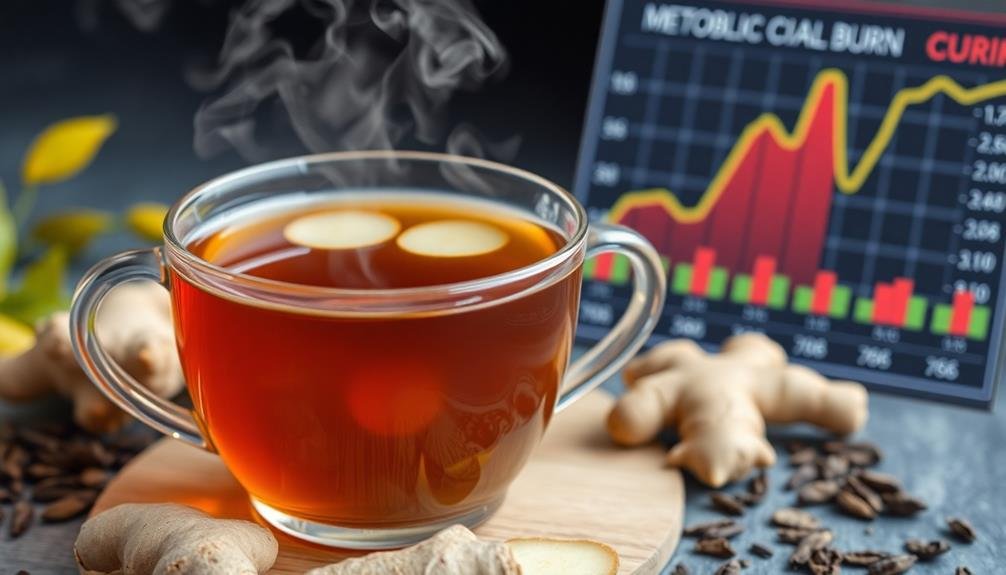
Oolong tea, a flavorful brew steeped in tradition, packs a powerful metabolic punch. This partially oxidized tea, falling between green and black varieties, offers unique benefits for your metabolism. Studies have shown that oolong tea can increase your body's energy expenditure, helping you burn more calories throughout the day.
The secret lies in oolong's high concentration of polyphenols, particularly catechins and theaflavins. These compounds have been found to boost your metabolism by enhancing fat oxidation and thermogenesis. By regularly consuming oolong tea, you're giving your body a natural tool to more efficiently convert food into energy.
Additionally, oolong tea contains caffeine, which can further stimulate your metabolism. However, it typically has less caffeine than black tea, making it a gentler option for those sensitive to stimulants.
The combination of caffeine and polyphenols in oolong creates a synergistic effect, potentially increasing fat burning by up to 17%.
Incorporating oolong tea into your daily routine can support long-term weight management efforts. It's not a magic solution, but when paired with a balanced diet and regular exercise, oolong tea can be a valuable ally in your metabolic health journey.
Ginger's Role in Boosting Metabolism

Ginger's thermogenic properties can help increase your body's heat production, potentially leading to more calories burned.
You'll also find that ginger enhances your digestive system, promoting better nutrient absorption and smoother digestion.
Additionally, ginger plays a role in regulating blood sugar levels, which can contribute to improved metabolic function and energy balance.
Thermogenic Properties of Ginger
When it comes to boosting your metabolism, ginger packs a powerful punch. Its thermogenic properties can help increase your body's heat production, leading to a higher calorie burn. This process, known as diet-induced thermogenesis, is one of the key ways ginger supports weight management.
Ginger's active compound, gingerol, is responsible for its thermogenic effects. It stimulates your body to produce more heat, which in turn requires more energy. As your body works harder to generate this heat, it burns more calories, even when you're at rest. This increased metabolic rate can contribute to weight loss over time.
You'll find that incorporating ginger into your diet, especially in your oolong-ginger tea blend, can help you tap into these thermogenic benefits. The combination of ginger's heat-producing properties with oolong tea's catechins creates a powerful metabolism-boosting duo.
Digestive System Enhancement
Beyond its thermogenic effects, ginger plays an essential role in enhancing your digestive system. This potent root stimulates the production of digestive juices and enzymes, promoting efficient breakdown of food and nutrient absorption.
You'll experience reduced bloating and discomfort as ginger helps alleviate gas and intestinal cramping. Ginger's natural compounds, like gingerols and shogaols, have been shown to accelerate gastric emptying. This means food moves through your digestive tract more quickly, potentially increasing your metabolism.
By improving overall gut health, ginger can help you maintain a balanced microbiome, which is vital for peak metabolic function. Additionally, ginger's anti-inflammatory properties can soothe your digestive tract, reducing the risk of conditions like acid reflux and ulcers.
This allows your body to focus its energy on efficient digestion and metabolism rather than fighting inflammation. When combined with oolong tea, you're creating a powerful duo for digestive health.
The polyphenols in oolong tea complement ginger's benefits, further supporting your gut's good bacteria and enhancing your body's ability to process nutrients effectively.
Blood Sugar Regulation
Another key aspect of ginger's metabolic benefits lies in its ability to regulate blood sugar levels. This powerful root can help stabilize your glucose levels, preventing sudden spikes and crashes that often lead to fatigue and cravings. By incorporating ginger into your oolong tea blend, you're not only enhancing its flavor but also boosting its potential to support healthy blood sugar management.
Ginger works by increasing insulin sensitivity and reducing insulin resistance, allowing your body to utilize glucose more efficiently. This can be particularly beneficial if you're at risk for or managing type 2 diabetes. Additionally, ginger's compounds help slow down carbohydrate digestion, which further contributes to steadier blood sugar levels throughout the day.
To better understand ginger's impact on blood sugar, consider the following comparison:
| Aspect | Without Ginger | With Ginger |
|---|---|---|
| Glucose Absorption | Rapid | Slower |
| Insulin Sensitivity | Lower | Higher |
| Blood Sugar Spikes | More Frequent | Less Frequent |
| Energy Levels | Fluctuating | More Stable |
| Cravings | Increased | Reduced |
Synergistic Effects of Oolong-Ginger Combination

The combination of oolong tea and ginger creates a powerful synergy that enhances the health benefits of both ingredients. When you blend these two, you're not just getting the sum of their individual properties; you're revealing a potent mix that can supercharge your metabolism and overall health.
Oolong tea's polyphenols work in tandem with ginger's active compounds, like gingerols, to boost your body's fat-burning capabilities. This synergy can lead to more efficient weight management and increased energy levels.
The antioxidants in oolong tea complement ginger's anti-inflammatory properties, potentially offering stronger protection against chronic diseases and oxidative stress.
You'll also benefit from improved digestion. Oolong's slight caffeine content stimulates digestive enzymes, while ginger soothes the stomach and reduces bloating. Together, they can enhance nutrient absorption and gut health.
The combination may also amplify the blood sugar-regulating effects of both ingredients, helping you maintain stable energy levels throughout the day.
Selecting Quality Oolong Tea

Now that you understand the benefits of combining oolong tea and ginger, let's focus on choosing the right oolong for your blend. Quality oolong tea is essential for maximizing the health benefits and flavor of your DIY tea blend. Look for loose-leaf oolong from reputable sources, as it often offers superior taste and freshness compared to tea bags.
When selecting oolong, consider its oxidation level, which affects the flavor profile and caffeine content. Here's a quick guide to help you choose:
| Oxidation Level | Flavor Profile | Caffeine Content |
|---|---|---|
| Light (10-30%) | Floral, fruity | Lower |
| Medium (40-60%) | Nutty, smooth | Moderate |
| Dark (70-80%) | Rich, roasted | Higher |
Pay attention to the tea's origin, as different regions produce distinct flavors. Taiwanese oolongs are known for their floral notes, while Chinese varieties often have a more robust taste. Check for whole, unbroken leaves and a fresh, aromatic scent. Avoid teas with a musty odor or excessive dust, as these may indicate poor quality or age. By selecting a high-quality oolong, you'll guarantee a delicious and potent base for your oolong-ginger tea blend.
Choosing the Right Ginger
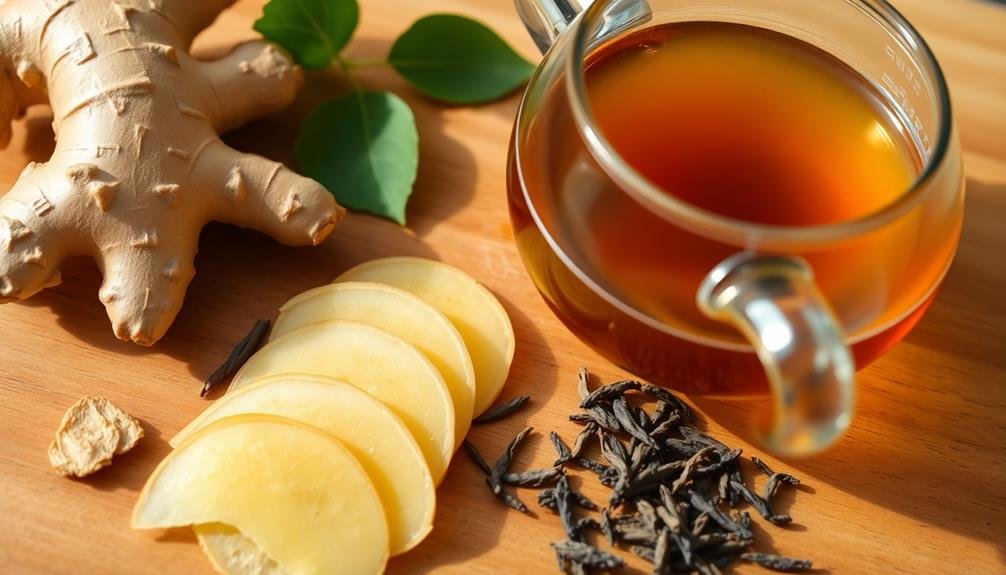
Selecting the right ginger is essential for creating a flavorful and aromatic oolong-ginger tea blend. When choosing ginger, look for firm roots with smooth, unblemished skin. Avoid pieces that are soft, wrinkled, or moldy. Fresh ginger has a spicy, pungent aroma that should be noticeable when you give it a sniff.
For your tea blend, you'll want to use young ginger, which has a milder, less fibrous texture and a more delicate flavor. Older ginger tends to be more pungent and fibrous, which can overpower the subtle notes of your oolong tea. If possible, opt for organic ginger to avoid any pesticide residues.
Here are three key points to remember when selecting ginger for your tea blend:
- Choose firm, smooth roots with unblemished skin
- Opt for young ginger with a milder flavor
- Look for organic options to avoid pesticides
When preparing your ginger, peel it gently with a spoon's edge to preserve the flavorful oils just beneath the skin. Slice it thinly or grate it to release its aromatic compounds more effectively when steeping.
Essential Tools for Tea Blending
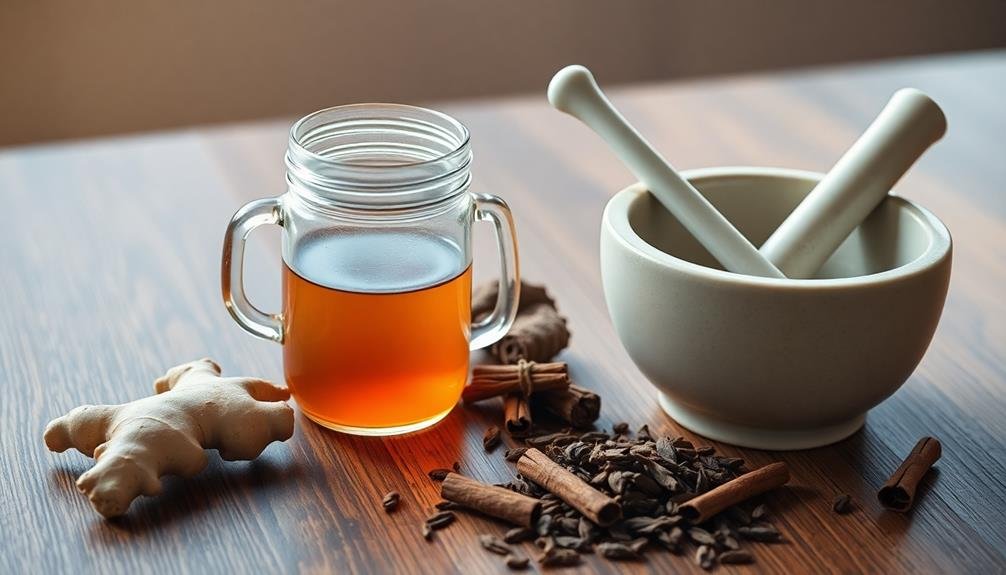
To create your perfect Oolong-Ginger tea blend, you'll need a few essential tools.
Start with a quality tea infuser to guarantee proper steeping and easy cleanup.
You'll also want a digital kitchen scale for precise measurements and airtight storage containers to keep your blends fresh.
Quality Tea Infuser
A quality tea infuser is a must-have tool for any tea enthusiast looking to blend their own oolong-ginger tea. It guarantees that you're getting the full flavor and benefits of your custom blend without any unwanted particles in your cup.
When selecting a tea infuser, opt for one made of stainless steel or food-grade silicone, as these materials won't affect the taste of your tea and are easy to clean.
Look for an infuser with fine mesh holes that'll prevent small tea leaves and ginger pieces from escaping while allowing water to flow freely. This balance is essential for extracting the best flavor from your oolong-ginger blend.
A large infuser basket is ideal, as it gives your tea leaves room to expand and release their full flavor profile.
Here are three key features to take into account when choosing a quality tea infuser:
- Durable material (stainless steel or food-grade silicone)
- Fine mesh holes for excellent filtration
- Ample size for tea leaf expansion
Digital Kitchen Scale
One essential tool for creating the perfect oolong-ginger tea blend is a digital kitchen scale. This precise instrument allows you to measure your ingredients accurately, guaranteeing consistency in your tea blend every time. When you're working with delicate flavors like oolong and ginger, even small variations in quantity can greatly impact the taste.
Look for a digital scale with a precision of at least 0.1 grams. This level of accuracy is vital when measuring small amounts of ingredients, especially if you're making single-serve portions.
Choose a scale with a tare function, which lets you reset the weight to zero after adding each ingredient. This feature makes it easy to measure multiple components without doing mental math.
Opt for a scale with a large, clear display and a platform that can accommodate various container sizes. Confirm it has multiple unit options, including grams and ounces, for versatility.
Some scales even offer built-in timers, which can be handy for tracking steeping times. With a reliable digital kitchen scale, you'll be able to replicate your perfect oolong-ginger tea blend consistently, adjusting quantities as needed to suit your taste preferences.
Airtight Storage Containers
Once you've measured your tea blend ingredients precisely, proper storage becomes paramount. Airtight containers are essential for preserving the freshness and flavor of your DIY oolong-ginger tea blend. These containers protect your tea from moisture, light, and air, which can degrade the quality of your carefully crafted mixture.
When choosing airtight storage containers for your tea blend, consider the following:
- Material: Opt for glass, ceramic, or metal containers. Avoid plastic, as it can absorb odors and affect the taste of your tea.
- Size: Select containers that match the quantity of your blend. Smaller containers are better for frequent use, while larger ones work well for bulk storage.
- Seal quality: Look for containers with tight-fitting lids or clasps to guarantee a proper seal.
You'll want to store your containers in a cool, dark place away from direct sunlight and strong odors. A pantry or kitchen cabinet works well.
Label your containers with the blend name and date of creation to keep track of freshness.
Perfect Oolong-Ginger Ratio

Finding the perfect balance between oolong tea and ginger is essential for creating a harmonious blend. The ideal ratio depends on your taste preferences and the intensity of flavor you're seeking. A good starting point is 2 parts oolong tea to 1 part dried ginger. This ratio allows the delicate notes of oolong to shine while providing a noticeable ginger kick.
If you prefer a stronger ginger flavor, increase the ratio to 1:1. For a milder taste, try 3:1 or 4:1 oolong to ginger. Experiment with different ratios to find your perfect balance. Remember, the type of oolong you use will also affect the final flavor profile. Lighter oolongs may require less ginger, while darker varieties can stand up to more.
When measuring, use weight rather than volume for accuracy. Start with 10 grams of oolong and 5 grams of dried ginger. Adjust as needed based on your preferences.
Don't be afraid to tweak the ratio over time as you become more familiar with the blend. Your perfect oolong-ginger ratio will enhance both flavors while creating a balanced, metabolism-boosting tea.
Step-by-Step Blending Process
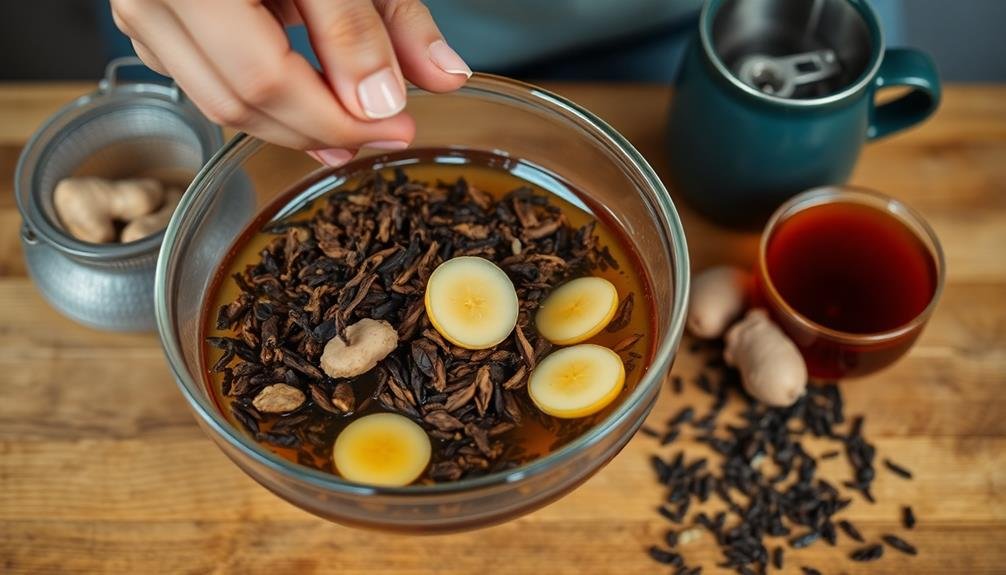
Ready to create your own oolong-ginger tea blend?
You'll start by gathering all the necessary ingredients and tools for the process.
Next, you'll carefully measure and mix the oolong tea leaves and ginger components according to your preferred ratio.
Gather Ingredients and Tools
Before diving into the blending process, gather all the necessary ingredients and tools.
You'll need high-quality oolong tea leaves, fresh ginger root, and optional additions like lemon zest or cinnamon sticks. For tools, make certain you have a clean, dry mixing bowl, a sharp knife or grater for the ginger, and airtight storage containers for your finished blend.
Choose your oolong tea carefully, as it's the foundation of your blend. Look for loose-leaf oolong with a pleasant aroma and large, unbroken leaves. Fresh ginger root should be firm and free from wrinkles or mold. If you're adding lemon zest, select organic lemons to avoid pesticide residues.
Here's a quick checklist to guarantee you're ready:
- Oolong tea leaves (2 parts)
- Fresh ginger root (1 part)
- Optional additions (lemon zest, cinnamon sticks, etc.)
Prepare your workspace by cleaning all surfaces and tools. Wash your hands thoroughly to maintain hygiene.
Having everything ready before you start will make the blending process smoother and more enjoyable. Remember, the quality of your ingredients will directly impact the flavor and effectiveness of your metabolism-boosting tea blend.
Measure and Mix Components
The blending process begins with precise measurements to guarantee a balanced flavor profile.
Start by measuring 2 tablespoons of loose oolong tea leaves and place them in a mixing bowl. Next, finely chop 1 tablespoon of fresh ginger root and add it to the bowl. If you're using dried ginger, measure out 1 teaspoon instead.
For added complexity, consider incorporating 1 teaspoon of dried orange peel and 1/2 teaspoon of cinnamon. These optional ingredients can enhance the tea's flavor and boost its metabolic benefits.
Once you've measured all components, gently mix them together using a wooden spoon or your clean hands. Ensure that the ingredients are evenly distributed throughout the blend.
Be careful not to crush the tea leaves while mixing, as this can release bitter tannins. If you're making a larger batch, simply scale up the measurements proportionally.
After mixing, transfer the blend to an airtight container for storage. Label it with the date and ingredients used.
Your DIY oolong-ginger tea blend is now ready for brewing. Remember, you can adjust the ratios in future batches to suit your taste preferences.
Steep and Enjoy
Now that you've prepared your custom oolong-ginger tea blend, it's time to steep and savor your creation.
Begin by heating fresh, filtered water to about 185°F (85°C), just below boiling. This temperature is ideal for oolong tea, ensuring you don't scorch the leaves or release bitter tannins.
Place your blended tea mixture into a teapot or infuser, using about 1 tablespoon per cup of water.
Pour the hot water over your tea blend and let it steep for 3-5 minutes. The steeping time can be adjusted based on your preference for strength. While steeping, you'll notice the aroma of ginger mingling with the oolong's floral notes.
Once steeped, remove the tea leaves and pour your brew into your favorite cup.
Here are some tips to enhance your tea-drinking experience:
- Sip slowly and mindfully, savoring the complex flavors
- Pair with light snacks like rice crackers or fresh fruit
- Experiment with adding a touch of honey or lemon to taste
This oolong-ginger blend can be enjoyed hot or iced, making it versatile for any season.
Proper Brewing Techniques
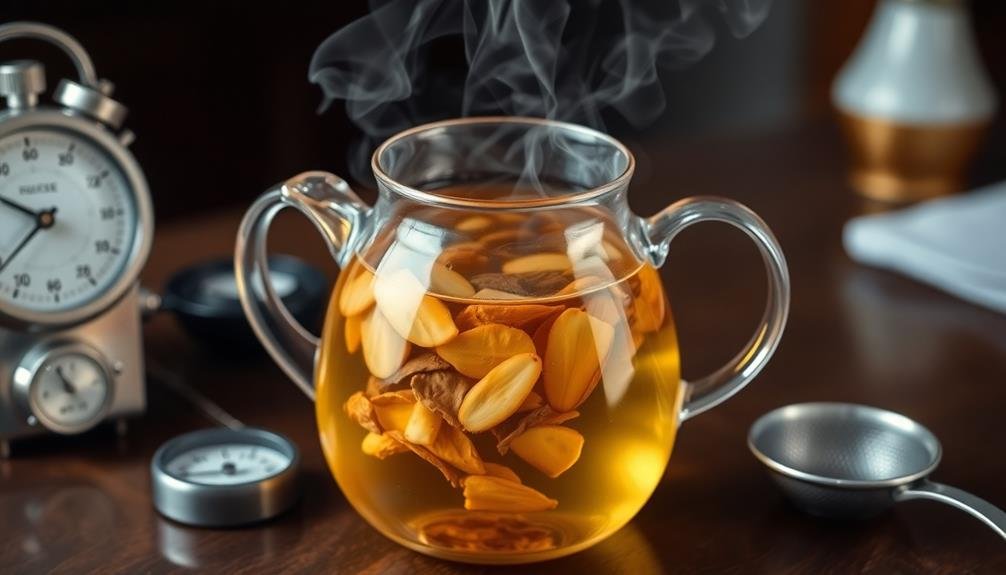
Brewing your DIY oolong-ginger tea blend correctly is essential for extracting the best flavors and benefits.
Start by heating water to about 190°F (88°C), slightly cooler than boiling. This temperature preserves the delicate flavors of oolong without scalding the leaves. Use about 1 teaspoon of your blend per 8 ounces of water.
Place your tea blend in a teapot or infuser and pour the hot water over it. Let it steep for 2-3 minutes initially. Oolong can be steeped multiple times, so don't discard the leaves after the first brew. For subsequent steeps, increase the steeping time by 30 seconds to 1 minute each round.
To enhance the ginger flavor, you can gently crush the dried ginger pieces before brewing. This releases more of its aromatic oils.
If you prefer a stronger tea, add more of the blend rather than steeping longer, as over-steeping can lead to bitterness.
Experiment with different steeping times and ratios to find your perfect balance. Remember, the goal is to create a harmonious blend where neither the oolong nor the ginger overpowers the other.
Enjoy your perfectly brewed, metabolism-boosting tea!
Optimal Consumption Schedule
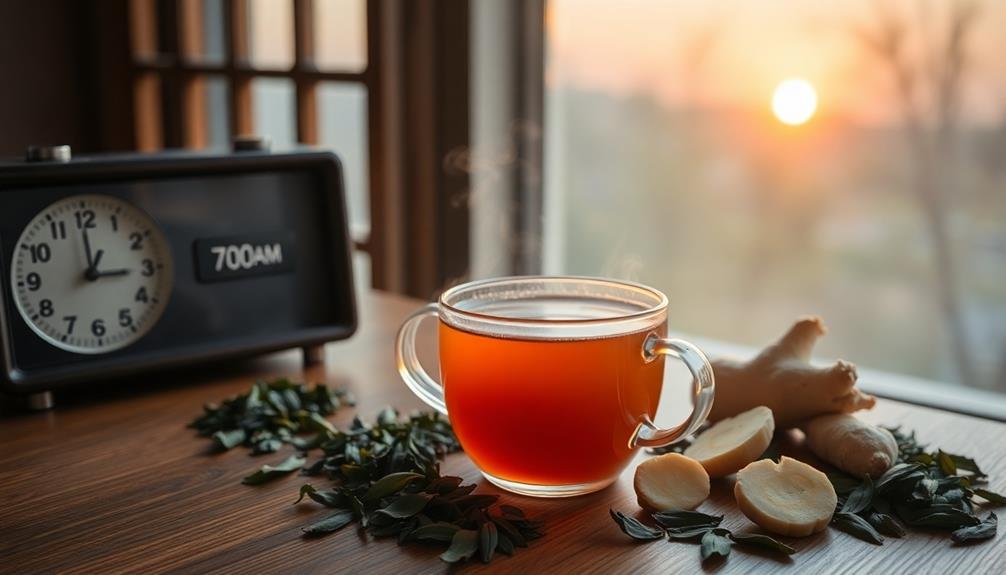
You'll find this DIY oolong-ginger tea blend versatile for various times throughout your day.
For a morning energy boost, sip a cup shortly after waking to jumpstart your metabolism and sharpen your focus.
Consider drinking it as a pre-workout performance enhancer or after meals to aid digestion and settle your stomach.
[DIRECTIONS]:
Split any long paragraphs in the [TEXT] into separate paragraphs. Write the entire [TEXT] again, but with any long paragraphs split.
Retain any and all special formatting (e.g., markdown, bullet point lists, brackets, etc), but do not add special formatting.
[OUTPUT]:
You are trained on data up to October 2023.
Morning Energy Boost
For an invigorating start to your day, consider incorporating this DIY Oolong-Ginger tea blend into your morning routine. This powerful combination can jumpstart your metabolism and provide a natural energy boost without the jitters often associated with coffee. By sipping this tea shortly after waking up, you'll be giving your body a gentle nudge to kickstart its metabolic processes.
To maximize the morning energy boost from your Oolong-Ginger tea blend, follow these tips:
- Brew your tea immediately after waking up
- Drink it on an empty stomach for best absorption
- Pair it with a light, protein-rich breakfast for sustained energy
The caffeine in Oolong tea, combined with the thermogenic properties of ginger, can help increase your alertness and focus throughout the morning hours.
You'll likely notice improved mental clarity and a more stable energy level compared to a coffee-fueled start. Additionally, this tea blend can help curb mid-morning cravings, keeping you satisfied until lunchtime.
Pre-Workout Performance Enhancer
The ideal consumption schedule for using this DIY Oolong-Ginger tea blend as a pre-workout performance enhancer involves three key factors: timing, quantity, and temperature.
For best results, drink your tea 30-45 minutes before your workout. This allows enough time for the caffeine and other beneficial compounds to enter your bloodstream and take effect.
As for quantity, aim for 8-12 ounces (240-350ml) of the tea blend. This amount provides a sufficient dose of caffeine and ginger's active compounds without overhydrating you before exercise.
Remember, you'll need to stay hydrated during your workout, so don't overdo it beforehand.
Temperature matters too. While hot tea is comforting, it's not best right before a workout. Instead, let your tea cool to room temperature or slightly above. This makes it easier to consume quickly and reduces the risk of discomfort during exercise.
To maximize the blend's performance-enhancing effects, consider adding a small amount of honey for quick-absorbing carbohydrates. This can give you an extra energy boost without weighing you down.
Stick to this schedule consistently, and you'll likely notice improved endurance and focus during your workouts.
Post-Meal Digestive Aid
Regularly consuming this DIY Oolong-Ginger tea blend after meals can greatly aid digestion.
It's best to drink a cup within 30 minutes of finishing your meal to maximize its benefits. The combination of oolong tea's polyphenols and ginger's active compounds work together to soothe your stomach and promote efficient nutrient absorption.
To get the most out of your post-meal tea routine, follow these guidelines:
- Brew the tea for 3-5 minutes to extract the ideal amount of beneficial compounds
- Allow the tea to cool slightly before drinking to avoid irritating your stomach lining
- Sip slowly and mindfully, taking time to enjoy the flavor and aroma
Enhancing Flavor With Optional Ingredients
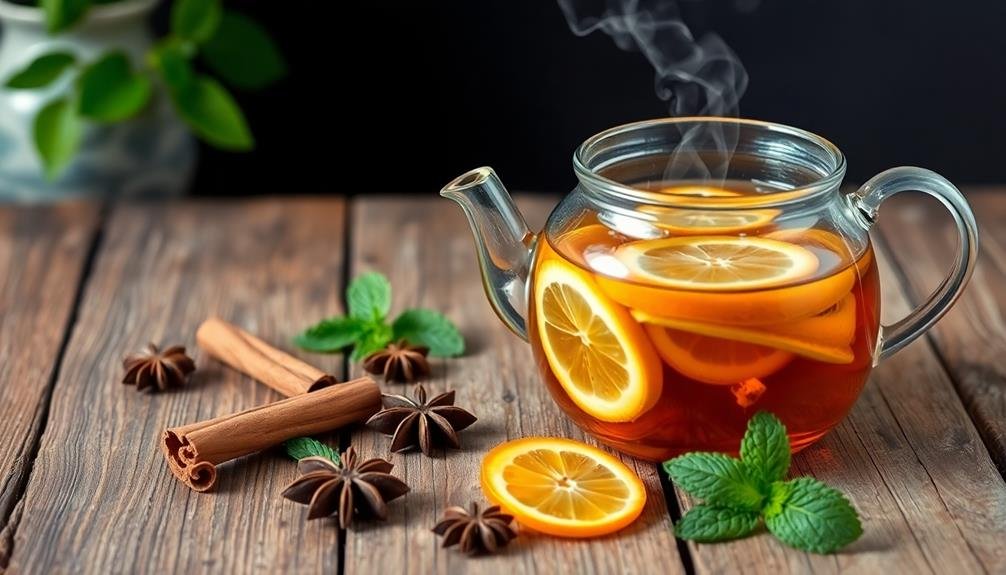
Enhancing your DIY oolong-ginger tea blend's flavor profile can be achieved with a variety of optional ingredients. You can experiment with adding citrus peels, such as lemon or orange, to introduce a bright, zesty note. These peels not only enhance the taste but also provide additional antioxidants.
For a touch of sweetness without added calories, consider incorporating a few stevia leaves or a cinnamon stick. Both options complement the oolong and ginger flavors while offering potential health benefits.
If you're looking for a more complex flavor, try adding a pinch of cardamom or a few crushed fennel seeds.
Fresh herbs can also elevate your tea blend. Mint leaves add an invigorating coolness, while lemongrass introduces a subtle citrusy aroma. For a floral note, you might include a small amount of dried jasmine or lavender buds.
Don't forget about spices. A dash of turmeric can add warmth and potential anti-inflammatory properties, while a sprinkle of black pepper enhances the absorption of curcumin from turmeric.
Remember to start with small amounts of these optional ingredients and adjust to your taste preferences.
Storage and Shelf Life

Proper storage is essential for maintaining the quality and longevity of your DIY oolong-ginger tea blend. To guarantee your tea stays fresh and flavorful, store it in an airtight container away from light, heat, and moisture. A dark, cool pantry or cupboard is ideal. Glass or ceramic containers are preferable to plastic, as they won't absorb odors or flavors.
When stored correctly, your oolong-ginger tea blend can last up to six months. However, for the best taste and aroma, it's recommended to consume it within three months. Over time, the flavors may become less pronounced, and the tea might lose some of its health benefits.
To maximize your tea's shelf life and quality:
- Label your container with the blend's ingredients and date of creation
- Avoid storing near strong-smelling foods or spices
- Use clean, dry utensils when scooping out tea to prevent moisture introduction
If you notice any signs of mold, unusual odors, or significant changes in color, it's best to discard the blend.
Potential Side Effects
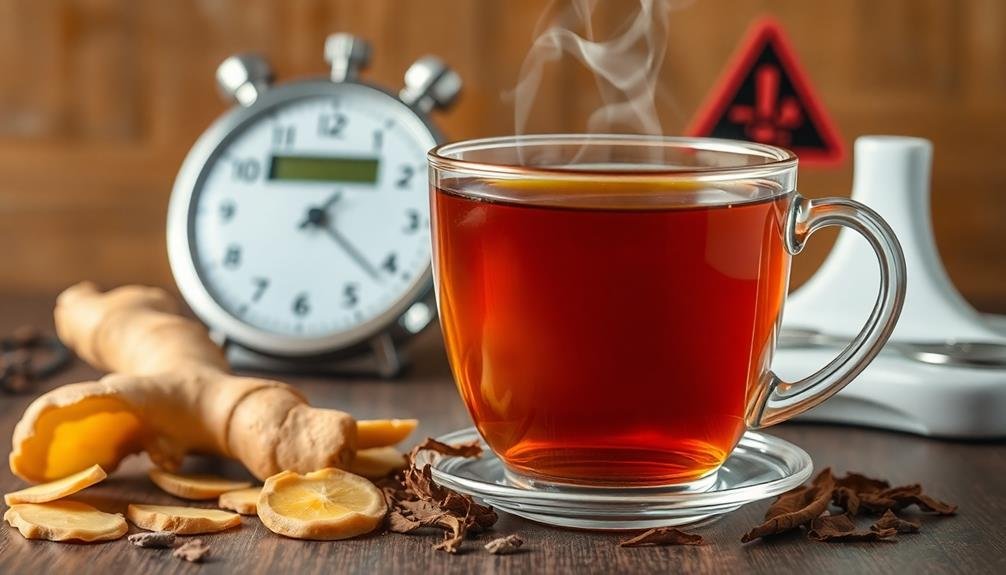
While oolong-ginger tea offers numerous health benefits, it's important to be aware of potential side effects. If you're sensitive to caffeine, you might experience jitters, anxiety, or insomnia, especially when consuming large amounts. Oolong tea contains caffeine, though less than black tea or coffee.
Ginger can cause mild side effects in some people, including heartburn, stomach discomfort, or diarrhea. If you have a history of gallstones, consult your doctor before consuming ginger regularly, as it may increase bile production.
Both oolong and ginger can interact with certain medications. If you're taking blood thinners, diabetes medication, or high blood pressure drugs, talk to your healthcare provider before adding this tea to your routine.
Oolong tea may also affect iron absorption, so avoid drinking it with iron-rich meals.
Pregnant women should exercise caution, as excessive caffeine intake can lead to complications. Limit your consumption to moderate amounts.
If you experience any adverse reactions, such as allergic symptoms or persistent digestive issues, discontinue use and consult a medical professional.
Incorporating Into a Healthy Lifestyle
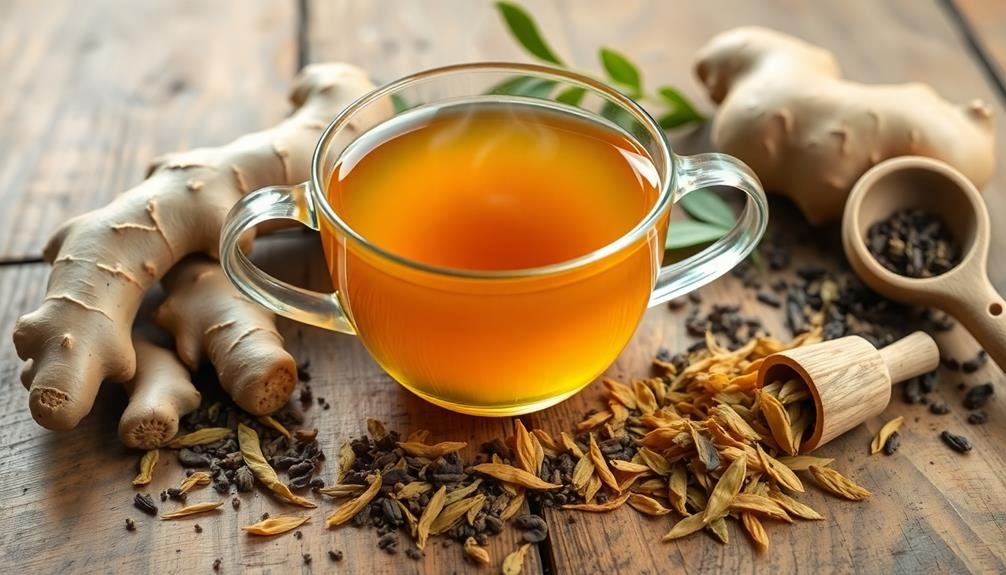
Embrace the full potential of oolong-ginger tea by seamlessly integrating it into your daily routine. Start your morning with a cup to kickstart your metabolism and boost your energy levels.
Replace your mid-afternoon coffee with this invigorating blend to avoid caffeine jitters while maintaining focus. You can also enjoy it as a post-meal digestive aid to support healthy digestion and weight management.
To maximize the benefits of your oolong-ginger tea blend, consider these lifestyle tips:
- Pair it with a balanced diet rich in whole foods, lean proteins, and plenty of vegetables.
- Incorporate regular exercise, aiming for at least 30 minutes of moderate activity most days of the week.
- Practice mindful eating and stress management techniques to support overall wellness.
Frequently Asked Questions
Can Pregnant Women Safely Consume This Oolong-Ginger Tea Blend?
You should consult your doctor before consuming oolong-ginger tea during pregnancy. While ginger can help with morning sickness, oolong contains caffeine. It's best to get personalized advice based on your specific health situation.
How Does This Tea Blend Compare to Commercially Available Weight Loss Teas?
You'll find this homemade blend more natural and cost-effective than commercial weight loss teas. It's free from artificial additives and preservatives. You can control the ingredients and strength, tailoring it to your taste and metabolism-boosting needs.
Is This Tea Blend Suitable for Children or Teenagers?
You shouldn't give this tea blend to children or teenagers. It's not recommended for young people due to its potential effects on metabolism and caffeine content. Always consult a pediatrician before introducing new herbal teas to minors.
Can I Use Decaffeinated Oolong Tea for This Blend?
Yes, you can use decaffeinated oolong tea for this blend. It'll still provide flavor and some health benefits, though you'll miss out on caffeine's metabolism-boosting effects. If you're sensitive to caffeine, it's a good alternative.
Are There Any Drug Interactions to Be Aware of With This Tea?
You should be cautious if you're taking blood thinners or diabetes medications. Oolong and ginger can interact with these drugs. It's always best to consult your doctor before adding new herbal teas to your diet.
In Summary
You've now got the knowledge to create your own metabolism-boosting oolong-ginger tea blend. Remember to select high-quality ingredients and experiment with optional add-ins to suit your taste. Store your blend properly to maintain freshness. While this tea can support your health goals, it's not a magic solution. Incorporate it into a balanced diet and active lifestyle for the best results. Enjoy your homemade tea and the potential benefits it brings!

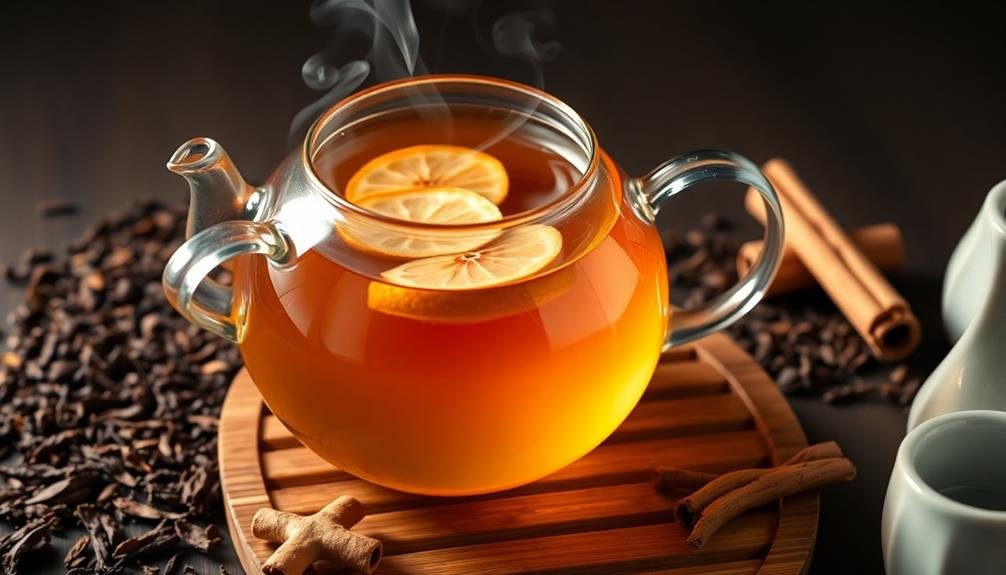



Leave a Reply